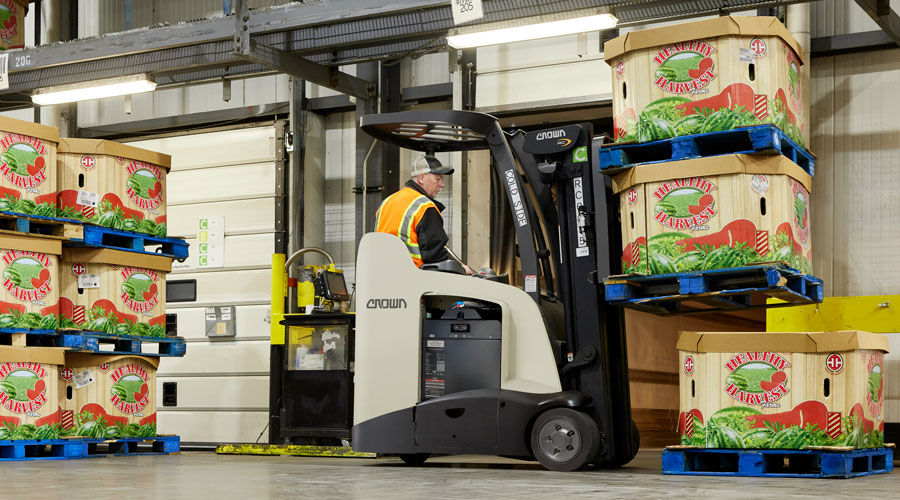Adopting Lithium-Ion Forklifts in Your Cold Storage Environment

The cold chain sector continues to grow, and facility operators face the challenge of keeping up with customer demand and managing the high energy costs of refrigeration. Consequently, facility operators are constantly seeking ways to improve productivity and maintain or increase throughput, including analyzing their fleets’ lead-acid or lithium-ion power sources.
The Challenges of Lead-Acid Batteries in Cold Storage
Lead-acid batteries can lose 30% of their rated capacity when used in temperatures below 32° F. With just 70% of the battery’s available capacity its discharge/charge cycle is significantly reduced.
With a lead-acid battery, the lift truck must exit the cold storage environment when it is time for a battery change. The sudden transition between temperatures can cause condensation to form, potentially leading to performance issues and downtime.
Unless allowed to warm up prior to charging, a cold lead-acid battery may also experience an artificial spike in voltage when charging, which can result in premature stoppage of the charging cycle. If this happens regularly, the battery may be short charged over time, negatively impacting its capacity and lifecycle.
For years, these issues with using lead-acid batteries in cold storage were accepted as a cost of doing business. Now that lithium-ion batteries are being used in material handling, many cold storage environments are adopting lithium-ion as their energy solution because they experience fewer performance issues and limitations.
The Appeal of Lithium-Ion Batteries
Compared to lead-acid batteries, lithium-ion batteries offer many benefits in cold storage applications:
- Reduced maintenance and risk: Lithium-ion batteries don’t require watering or expose employees to hazardous gases or chemicals during battery servicing and charging.
- Faster, more convenient recharging: Unlike lead-acid batteries, lithium-ion batteries can be opportunity charged without negatively impacting the battery, and they don’t need to be removed from the forklift during brief charging breaks. Also, they don’t require a cooldown period after recharge.
- Reclaimed storage space: Lead-acid batteries require designated charging rooms that take up valuable warehouse space and can require multiple batteries per lift truck in multi-shift applications. Lithium-ion batteries can be charged directly on the lift truck, with chargers placed in convenient spaces near break rooms.
- Longer lifespan and run time: Crown’s V-Force® lithium-ion batteries have a significantly longer lifespan—up to 3,600 cycles, which can equate to about six years of use. They also offer up to three times more throughput than lead-acid batteries in daily operations.
Although lithium-ion batteries require a larger investment upfront, the advantages may be worth it in your operation. The following four tips can help you make your decision.
1. Know your power profile
Forklifts consume power differently depending on the application, operator and driving patterns. Conducting a power study can help you determine if lithium-ion batteries are the right choice for your operation by helping you understand how your lift trucks are using power in your application.
2. Choose an integrated lithium-ion forklift system
Seamlessly integrating lithium-ion technology into your forklifts helps optimize performance, safety and efficiency. Modern lithium-ion systems include onboard intelligence that communicates with the forklift, ensuring that safety features are maintained as the battery’s charge is depleted. You can also choose batteries with on-board heaters to help prevent performance issues in cold environments.
3. Strategically place your charging stations
Chargers that can operate in cold storage environments can eliminate the need for forklifts to leave the cold zone for charging, reducing downtime and condensation risk. Charging stations should be placed where there is sufficient room for proper cable management and easy access, which minimizes wear and tear on connectors.
4. Provide operator training
Introducing lithium-ion technology requires proper training to ensure operators understand how to get the most out of their equipment. Training should focus on how lithium-ion differs from lead-acid and what changes in charging behavior can help maximize battery life and runtime.
Lithium-ion batteries can help address many of the performance issues that lead-acid batteries encounter in cold storage. However, it’s essential to evaluate whether this technology aligns with your operation’s needs to ensure you gain the most from your investment.